|
The MG248Q offers a good range of connectivity
options with DisplayPort, HDMI 1.4 and Dual-link DVI
connections offered. The digital interfaces are HDCP certified for encrypted content and the
video cables are provided in the box for DisplayPort and DL-DVI, but not HDMI.
The screen has an external power supply and comes
packaged with the small power brick and cable you need. There is an audio in and
headphone out
connection as well, along with 2x 2W stereo speakers, but no USB ports at all which is quite rare on modern
screens.
Below is a summary of the features and connections
of the screen:
|
Feature |
Yes / No |
Feature |
Yes / No |
|
Tilt adjust |
 |
DVI |
 |
|
Height adjust |
 |
HDMI |
 |
|
Swivel adjust |
 |
D-sub |
 |
|
Rotate adjust |
 |
DisplayPort |
 |
|
VESA compliant |
 |
Component |
 |
|
USB 2.0 Ports |
 |
Audio connection |
 |
|
USB 3.0 Ports |
 |
HDCP Support |
 |
|
Card Reader |
 |
MHL Support |
 |
|
Ambient Light Sensor |
 |
Integrated Speakers |
 |
|
Human Motion Sensor |
 |
PiP / PbP |
 |
|
Touch Screen |
 |
Blur Reduction Mode |
 |
|
Factory Calibration |
 |
G-Sync |
 |
|
Hardware calibration |
 |
FreeSync |
 |
|
Uniformity correction |
 |
Wireless charging |
 |

Design and Ergonomics


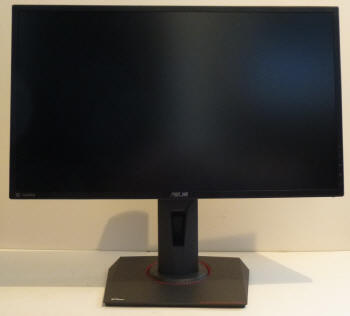
Above: front views of the screen. Click for larger versions
The MG248Q comes in an attractive design which is
quite similar overall to the popular
ROG Swift PG278Q and
PG279Q. This model isn't part of that Republic of Gaming (ROG) brand, but it
carries some of the design traits of those models. It is a mostly black design,
with matte plastics used for the bezel, back, stand and base. There is a shiny
silver Asus logo in the middle of the bottom bezel and grey DisplayPort and HDMI
logos in the bottom left hand corner. The bezel measures ~11.5mm around all
sides so looks pretty thin, although technically it's not a "borderless" panel
like the ROG screens. Although on those models even though there's a thin
plastic border, there's still a total 10mm black edge when you account for the
panel border around the screen so it makes little difference.
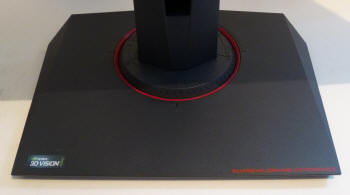
Above: view of
the base of the stand. Click for larger version
There is some red trim in places on the base where
there is a circular section around the monitor arm, reminiscent of the light-up
red ring on the ROG Swift PG278Q/PG279Q models (this doesn't light up here).
There is also a red font for the "supreme gaming experience" slogan on the base
of the stand.

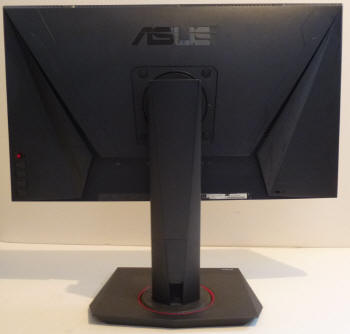
Above:
back views. Click for larger version
The back of the screen is a matte black plastic
and has a textured pattern as you can see above which looks nice. There is a
cable tidy hole in the stand which you can also pick out here. The stand can be
removed and the screen is VESA 100 compatible if you need. You will notice the
OSD control joystick and buttons on the left hand side of these pictures as
well.
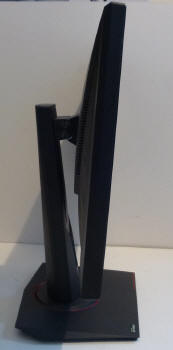 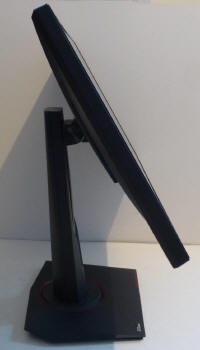
Above: full
tilt range shown. Click for larger versions
The screen offers a full range of ergonomic
adjustments. Tilt is smooth and easy to move, offering a good
adjustment range as shown above.
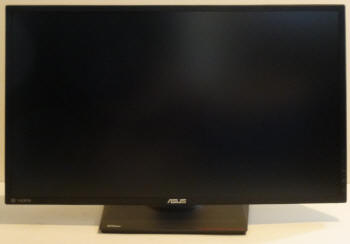
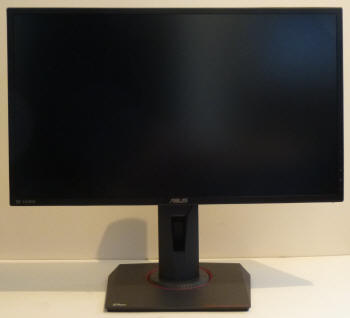
Above: full
height adjustment range shown. Click for larger versions
The height adjustment is also smooth and easy to
move, providing a decent adjustment range as well. At the lowest setting
the bottom edge of the screen is ~25mm from the edge of the desk, and at
maximum extension it is ~155mm. This gives a total 130mm adjustment range.

Above:
rotation function shown
Side to side swivel is smooth and again easy
to move, with the base remaining stationary on the desk as you move it.
Rotation is also offered. It is a little stiff but at least fairly useable
on a screen this size. Overall the screen remained stable on the desk
although there was a bit of wobble if you knocked the screen.
A summary of the screens ergonomic adjustments
is shown below:
|
Function |
Range |
Smoothness |
Ease of Use |
|
Tilt |
Yes |
Smooth |
Easy |
|
Height |
130mm |
Smooth |
Easy |
|
Swivel |
Yes |
Smooth |
Easy |
|
Rotate |
Yes |
Quite Smooth |
A little stiff |
|
Overall |
Good range of adjustments,
smooth and easy to use. |
The materials were of a good standard and the
build quality felt very good as well. There was no audible noise from the screen,
even when conducting specific tests which can often identify buzzing issues.
The whole screen remained cool even during prolonged use as well which
was pleasing.

Above:
interface connections. Click for larger version
The back of the screen features the interface
connections as shown above. There are (from left to right) the power
connection, DisplayPort, DL-DVI, HDMI,
audio in and headphone out.

OSD Menu
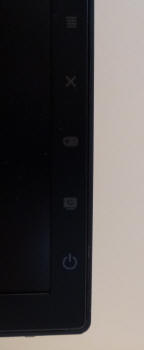
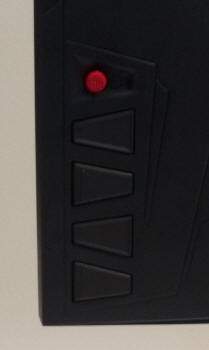
Above: OSD labels on front bezel (left), and control buttons on the back
(right)
Click for larger
version
The OSD menu is controlled primarily by a small
joystick control located on the back of the screen, in the bottom right hand
corner. This joystick is accompanied by 3 pressable buttons as well as an on/off
power button. There are small grey logos on the front bezel to help indicate the
location and function of each button on the back.
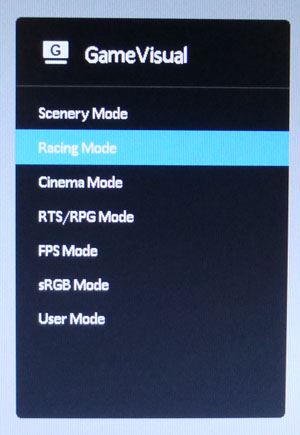
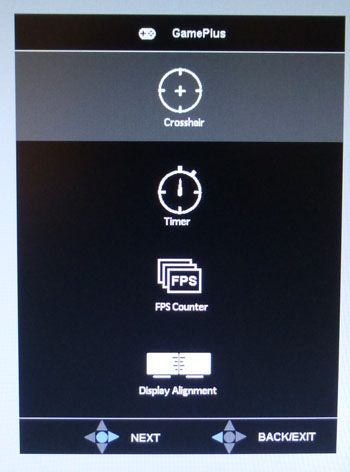
There is quick launch access via two of the
buttons to the GameVisual preset mode menu and the GamePlus features as shown
above.
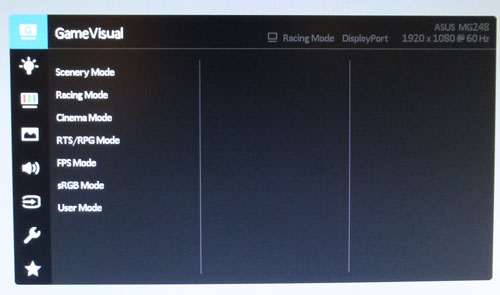
Pressing the joystick in brings up the main OSD
menu as shown above. This is split in to 8 sections down the left hand side,
with the options available in each section then showing on the right. Navigation
is quick, easy and intuitive thanks to the joystick control and there were lots
of options available as well. In this first section you can change the preset
mode again if you want, with each one being somewhat customisable and saveable.
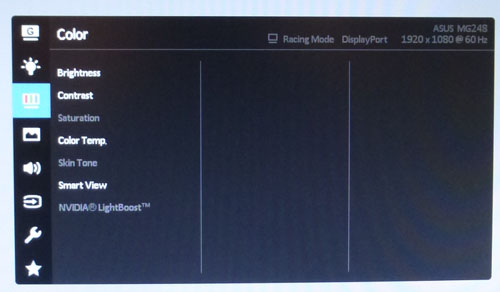
The 'Color' menu has controls for some of the main
functions like brightness, contrast, colour temp (inc RGB levels).
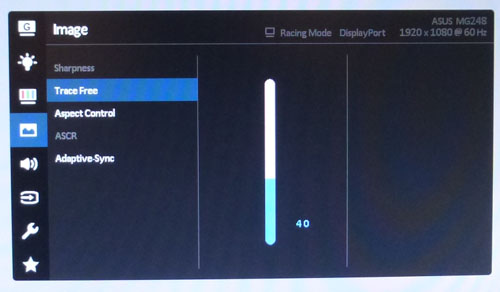
The 'image' section has a few advanced options
like the Trace Free overdrive control, aspect ratio control, and option to turn
FreeSync on/off if you're using a compatible AMD graphics card.
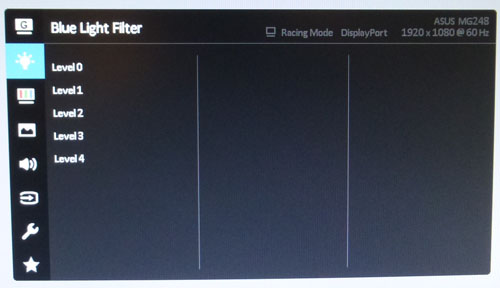
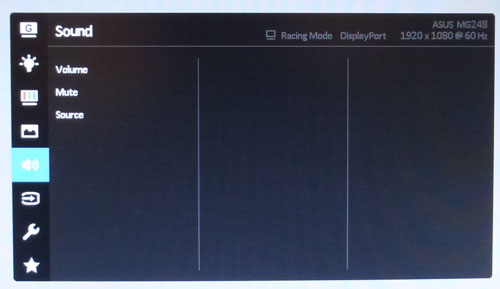
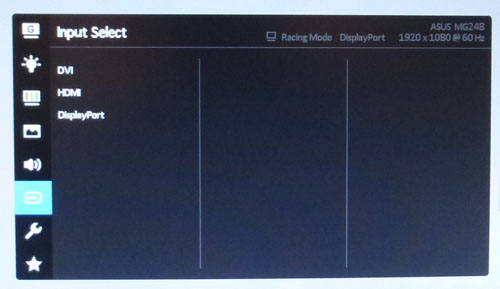
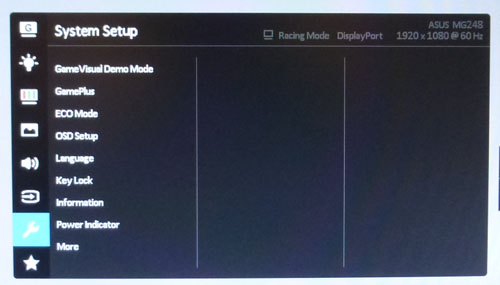
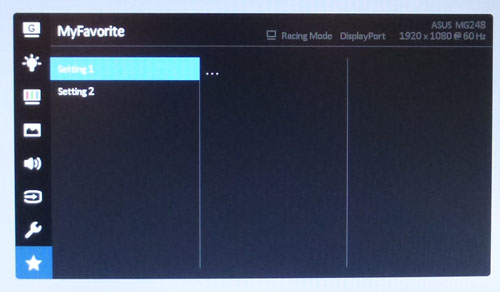
The other sections are fairly self-explanatory so
we won't go in to detail.

Power Consumption
In terms of power consumption the manufacturer
lists usage of <65.0W and <0.5W in standby mode. We carried out our normal tests to
establish its power consumption ourselves.
|
 |
|
State and Brightness
Setting |
Manufacturer Spec (W) |
Measured Power Usage
(W) |
|
Default (90%) |
<65.0 |
25.4 |
|
Calibrated (20%) |
- |
13.6 |
|
Maximum Brightness (100%) |
- |
26.6 |
|
Minimum Brightness (0%) |
- |
10.6 |
|
Standby |
<0.5 |
0.5 |
|
We tested this ourselves and found that out of the
box the screen used 25.4W at the default 90% brightness setting. At 100%
brightness this increased a little to 26.6W. Once calibrated the screen reached
13.6W consumption, and in standby it
used only 0.5W. We have plotted these results below compared with other screens
we have tested. The consumption is comparable to other monitors in this size
range as you might expect, and a little less than the bigger sized screens.


Panel and Backlighting
|
Panel Manufacturer |
AU Optronics |
Colour Palette |
16.7 million |
|
Panel Technology |
TN Film |
Colour Depth |
6-bit+ FRC ? |
|
Panel Module |
M240Q007 V0 |
Colour space |
Standard gamut |
|
Backlighting Type |
W-LED |
Colour space coverage (%) |
sRGB, ~72% NTSC |
Panel Part and Colour Depth
The Asus MG248Q features an
AU Optronics M240Q007 V0 TN Film technology panel which is capable of producing 16.7 million colours.
Although we do not have access to the full panel spec sheet, we believe is achieved through a 6-bit+FRC colour depth as with most
TN Film
panels of this size range.
The panel part is confirmed when dismantling the
screen as shown
below.
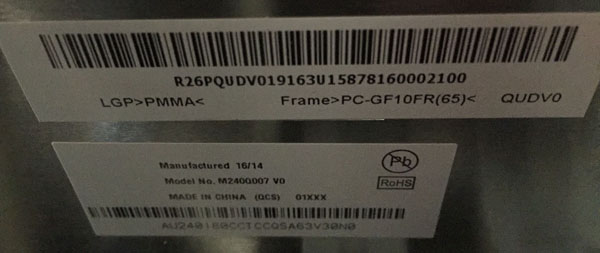
Screen
Coating
The
screen coating is a medium anti-glare (AG) offering. It isn't a semi-glossy
coating, and isn't as light as some modern IPS type panels either. It's in
keeping with other TN Film panels we've tested. Thankfully it isn't a heavily
grainy coating like some old IPS panels feature, although there is some
graininess noticeable. It retains its anti-glare properties to avoid too many
unwanted reflections of a full glossy coating, but does not produce an too
grainy or dirty an image that some thicker AG coatings can. There were some
slight cross-hatching patterns visible on the coating as well but only if you
looked very closely.
Backlight Type and Colour Gamut
The screen uses a White-LED (W-LED) backlight unit
which is standard in today's market. This helps reduce power consumption
compared with older CCFL backlight units and brings about some environmental
benefits as well. The W-LED unit offers a standard colour gamut which is
approximately equal to the sRGB colour space. Asus quote 72 % NTSC coverage as
well. Anyone wanting to work with wider colour spaces would need to consider
wide gamut CCFL screens or the newer range of GB-r-LED type (and similar)
displays available now. If you want to read more about colour spaces and gamut
then please have a read of our
detailed article.
Backlight
Dimming and Flicker
We tested the screen to establish the methods used
to control backlight dimming. Our in depth article talks in more details about a
common method used for this which is called
Pulse Width Modulation (PWM). This in itself gives cause for concern to some
users who have experienced eye strain, headaches and other symptoms as a result
of the flickering backlight caused by this technology. We use a photosensor +
oscilloscope system to measure backlight dimming control
with a high level of accuracy and ease. These tests allow us to establish
1) Whether PWM is being used to control the
backlight
2) The frequency and other characteristics at which this operates, if it is used
3) Whether a flicker may be introduced or potentially noticeable at certain
settings
If PWM is used for backlight dimming, the higher
the frequency, the less likely you are to see artefacts and flicker. The duty
cycle (the time for which the backlight is on) is also important and the shorter
the duty cycle, the more potential there is that you may see flicker. The other
factor which can influence flicker is the amplitude of the PWM, measuring the
difference in brightness output between the 'on' and 'off' states. Please
remember that not every user would notice a flicker from a backlight using PWM,
but it is something to be wary of. It is also a hard thing to quantify as it is
very subjective when talking about whether a user may or may not experience the
side effects.
100% 50%
0%



Above scale = 1
horizontal grid = 5ms
At 100% brightness a constant voltage is applied
to the backlight. As you reduce the brightness setting to dim the backlight a
Direct Current (DC) method is used, as opposed to any form of PWM. This applies
to all brightness settings from 100% down to 0%. The screen is flicker free as
advertised, which is excellent news.
|
Pulse Width
Modulation Used |
No |
|
Cycling
Frequency |
n/a |
|
Possible
Flicker at |
|
|
100% Brightness |
No |
|
50% Brightness |
No |
|
0% Brightness |
No |
For an up to date list of all flicker-free (PWM free) monitors please see our
Flicker Free Monitor Database.

Contrast
Stability and Brightness
We wanted to see how much variance there was in
the screens contrast as we adjusted the monitor setting for brightness.
In theory, brightness and contrast are two independent parameters, and good
contrast is a requirement regardless of the brightness adjustment.
Unfortunately, such is not always the case in practice. We recorded the
screens luminance and black depth at various OSD brightness settings, and
calculated the contrast ratio from there. Graphics card settings were left at
default with no ICC profile or calibration active. Tests were made using an
X-rite i1 Display Pro colorimeter. It should be noted that we used the
BasICColor calibration software here to record these, and so luminance at
default settings may vary a little from the LaCie Blue Eye Pro report.
|
OSD
Brightness |
Luminance
(cd/m2) |
Black
Point (cd/m2) |
Contrast
Ratio
( x:1) |
|
100 |
346.37 |
0.31 |
1117 |
|
90 |
319.25 |
0.29 |
1101 |
|
80 |
293.07 |
0.26 |
1127 |
|
70 |
266.32 |
0.24 |
1110 |
|
60 |
240.49 |
0.22 |
1093 |
|
50 |
212.95 |
0.19 |
1121 |
|
40 |
185.01 |
0.17 |
1088 |
|
30 |
157.82 |
0.14 |
1127 |
|
20 |
128.91 |
0.12 |
1074 |
|
10 |
99.39 |
0.09 |
1104 |
|
0 |
70.76 |
0.06 |
1179 |
|
Total Luminance Adjustment Range
(cd/m2) |
275.61 |
Brightness OSD setting controls backlight? |
 |
|
Total Black Point
Adjustment Range (cd/m2) |
0.25 |
|
Average Static Contrast Ratio |
1113:1 |
PWM Free? |
 |
|
Recommended OSD setting
for 120 cd/m2 |
17 |
We conducted these tests in the default 'Racing'
GameVisual preset mode. The brightness control gave us a very good range of
adjustment. At the top end the maximum luminance reached 346
cd/m2 which
basically met the specified maximum brightness of 350 cd/m2 from the
manufacturer. There was a decent 276 cd/m2 adjustment range in total,
and so at the minimum setting you could reach down to a low luminance of 71 cd/m2.
This should be more than adequate for those wanting to work in darkened room
conditions with low ambient light. A setting of 17 in the OSD menu should return you a
luminance of around 120 cd/m2 at default settings in this preset mode
(Racing).
It should be noted that the
brightness regulation is controlled without the need for
Pulse Width Modulation, using a Direct Current (DC) method for all
brightness settings between 100 and 0% and so the screen is flicker free.

We have plotted the
luminance trend on the graph above. The screen behaves as it should in this
regard, with a reduction in the luminance output of the screen controlled by the
reduction in the OSD brightness setting. This is a linear relationship.

The average contrast ratio of
the screen was decent for a TN Film panel at 1113:1. This was fairly stable
across the brightness adjustment range as shown above with some fluctuation at
the lower brightness adjustment end below 20%.

Testing
Methodology
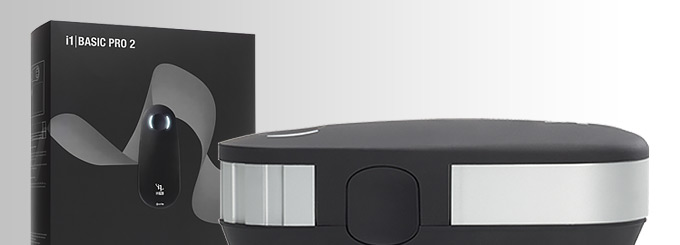
An
important thing to consider for most users is how a screen will perform out of
the box and with some basic manual adjustments. Since most users won't have
access to hardware colorimeter tools, it is important to understand how the
screen is going to perform in terms of colour accuracy for the average user.
We restored our graphics card to default settings
and disabled any previously active ICC profiles and gamma corrections. The
screen was tested at default factory settings using our
X-rite i1
Pro 2 Spectrophotometer combined with
LaCie's Blue Eye Pro software suite. An X-rite i1 Display Pro colorimeter was
also used to verify the black point and contrast ratio since the i1 Pro 2
spectrophotometer is less
reliable at the darker end.
Targets for these tests are as follows:
-
CIE Diagram - validates the colour space
covered by the monitors backlighting in a 2D view, with the black triangle representing the
displays gamut, and other reference colour spaces shown for comparison
-
Gamma - we aim for 2.2 which is the default
for computer monitors
-
Colour temperature / white point - we aim
for 6500k which is the temperature of daylight
-
Luminance - we aim for 120
cd/m2, which is
the recommended luminance for LCD monitors in normal lighting conditions
-
Black depth - we aim
for as low as possible to maximise shadow detail and to offer us the best
contrast ratio
-
Contrast ratio - we aim
for as high as possible. Any dynamic contrast ratio controls are turned off here
if present
-
dE average / maximum -
as low as possible.
If DeltaE >3, the color displayed is significantly different from the
theoretical one, meaning that the difference will be perceptible to the
viewer.
If DeltaE <2, LaCie considers the calibration a success; there remains a
slight difference, but it is barely undetectable.
If DeltaE < 1, the color fidelity is excellent.

Default Performance and
Setup
Default settings of the screen were as follows:
|
Monitor OSD Option |
Default Settings |
|
Preset GameVisual Mode |
Racing Mode |
|
Brightness |
90 |
|
Contrast |
80 |
|
Color Temp |
User Mode |
|
RGB |
100, 100, 100 |

Asus MG248Q - Default Settings, Racing mode





|
|
Default Settings
Racing mode |
|
luminance (cd/m2) |
349 |
|
Black Point (cd/m2) |
0.30 |
|
Contrast Ratio |
1154:1 |
Initially out of the box the screen was set in the
default 'Racing' GameVisual preset mode. The image looked very bright at the
default 90% brightness level and it looked a little washed out. It looked as if
the gamma was too low which is fairly common for gaming screens. The image also
felt a little cool and you could tell the screen was using a standard gamut
backlight as well with the naked eye.
We went
ahead and measured the default state with the i1 Pro. The
CIE diagram on the left of the image confirms that the monitors colour gamut
(black triangle) is fairly equal to
the sRGB colour space. There is some minor over-coverage in green and blue shades but not by anything significant.
Default gamma was recorded at 1.9 average, leaving it with a
12% deviance
from the target of 2.2 which was an issue for general desktop use. For gaming, its
often desirable to have a lower gamma level like this, and we've seen plenty of
gaming screens in the past with low gamma out of the box, so this isn't unusual.
However, given there is no gamma control in the OSD menu, it will be hard to correct without a calibration device. White
point was measured at a slightly cool 7349k, being 13%
out from the 6500k we'd ideally want for desktop use. Again, slightly cooler
setup is often preferred for gaming and multimedia.
Luminance was recorded at a very bright 349
cd/m2 which is
a too high for prolonged general use. The screen was set at a default
90% brightness in the OSD menu but that is easy to change of course to reach a
more comfortable setting without impacting any other aspect of the setup. The
black depth was 0.30 cd/m2 at this default brightness setting, giving
us an excellent (for a TN Film panel) static contrast ratio of
1154:1.
Colour accuracy was fairly decent out of the box
with an average dE of only 2.9, maximum of 5.4. Testing the screen with colour
gradients showed smooth transitions in all shades, with minor gradation evident
in darker tones. Overall this default setup was geared at gamers which is
probably to be expected. For general day to day desktop and other uses it is not
ideal as the gamma and white point are quite a long way off the desired levels.

We also wanted to test the screen out of the box in the 'sRGB' GameVisual preset
mode. This looked very similar to the default 'Racing' preset, and actually was
more limited as all the controls for brightness, contrast, colour temp and RGB
are now greyed out. We measured the setup nonetheless:
|
Monitor OSD Option |
Default Settings |
|
Preset GameVisual Mode |
sRGB Mode |
|
Brightness |
n/a |
|
Contrast |
n/a |
|
Color Temp |
n/s |
|
RGB |
n/a |

Asus MG248Q - Default Settings, sRGB mode
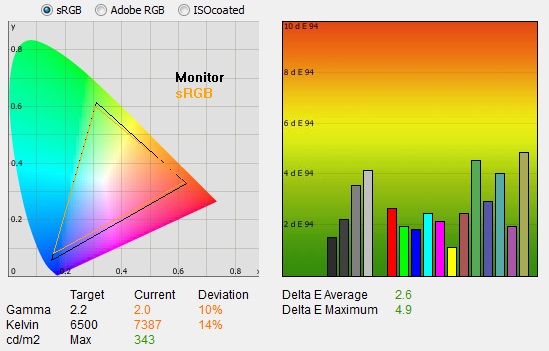

|
|
Default Settings
sRGB mode |
|
luminance (cd/m2) |
343 |
|
Black Point (cd/m2) |
0.30 |
|
Contrast Ratio |
1143:1 |
This preset mode showed basically no change
compared with the 'Racing' preset mode, other than an ever so slightly higher
gamma at 2.0 average (10% deviance now instead of 12%). Given all the controls
are locked in this mode, and how bright the screen is, we can't see any real use
for this preset.
|
Monitor OSD Option |
Default Settings |
|
Preset GameVisual Mode |
User Mode |
|
Brightness |
90 |
|
Contrast |
80 |
|
Color Temp |
User Mode |
|
RGB |
100, 100, 100 |

Asus MG248Q - Default Settings, User mode


|
|
Default Settings
User Mode |
|
luminance (cd/m2) |
342 |
|
Black Point (cd/m2) |
0.30 |
|
Contrast Ratio |
1141:1 |
The User preset mode gives you more control over
the settings and is probably a decent starting point to calibrate the screen to
a more comfortable setup for day to day general use. In this mode the gamma was
again slightly better, with an average of 2.0 measured and a smaller 8% deviance
from the 2.2 target. Gamma is going to be the main issue as it will be hard to
correct without a calibration device. White point was still too cool at 7505k,
but at least in this user mode you have access to adjust the RGB channels to
correct that fairly easily. Incidentally we measured the other colour temp
presets which returned the following measurements:
Cool - 16,973k
Normal - 7283k
Warm - 4784k
User - 7505 k
Luminance can be corrected easily enough through
the brightness control, now available again as normal in this 'user' preset.
Colour accuracy was pretty decent out of the box with an average dE of only 2.4.
Some OSD adjustments will help correct the white point and brightness nicely,
and the calibration device will help correct the gamma curve.

Calibration
We used the
X-rite i1 Pro 2
Spectrophotometer combined with the LaCie Blue Eye Pro software package to
achieve these results and reports. An X-rite i1 Display Pro colorimeter was used
to validate the black depth and contrast ratios due to lower end limitations of
the i1 Pro device.
|
Monitor OSD Option |
Calibrated Settings |
|
GameVisual Preset Mode |
User mode |
|
Brightness |
20 |
|
Contrast |
80 |
|
RGB |
100, 90, 83 |

Asus MG248Q - Calibrated Settings


|
|
Calibrated Settings |
|
luminance (cd/m2) |
121 |
|
Black Point (cd/m2) |
0.12 |
|
Contrast Ratio |
1005:1 |
We changed to the 'user' GameVisual preset mode which
had delivered the optimal starting point for our calibration, and offered us
access to the RGB controls from within the menu. We adjusted the RGB channels
and brightness setting as shown in the table above. All these OSD
changes allowed us to obtain an
optimum hardware starting point and setup before software level changes would be
made at the graphics card level. We left the LaCie software to calibrate
to "max" brightness which would just retain the luminance of whatever brightness
we'd set the screen to, and would not in any way try and alter the luminance at
the graphics card level, which can reduce contrast ratio. These adjustments
before profiling the screen would help preserve tonal values and limit
banding issues. After this we let the software carry out the LUT adjustments and create an
ICC profile.
Average gamma was now corrected to 2.2 average
with a 0% deviance, correcting the 8% deviance we'd seen out of the box in this preset mode
(2.0 average gamma). The
white point had now been corrected nicely to 6486k, bringing it in line with the
target and correcting the overly cool 15% deviance we'd seen by default.
Luminance had been improved thanks to the adjustment to the brightness control
and was now being measured at 121
cd/m2. This
left us a black depth of 0.12 cd/m2 and gave us a decent static
contrast ratio (for a TN Film panel) of
1005:1 which was on spec. Colour accuracy of the resulting
profile was very good, with dE average of 0.7 and maximum of 2.0. LaCie would
consider colour fidelity to be very good overall.
Testing the screen with various colour gradients
showed mostly smooth transitions but some slight banding in darker tones where
the gamma was being corrected at the graphics card level through the profilation
of the screen. There was some gradation in darker tones
also.
You can use our settings and
try our calibrated ICC profile if you wish, which are available in
our ICC profile database. Keep in mind that results will vary from one
screen to another and from one computer / graphics card to another.
Note: we had some later issues calibrating the
screen in this user mode. If you find the image looks off or wrong using these
settings from the user mode, try them instead in the racing mode. You should
still be able to use our recommended OSD settings and calibrated ICC profile in
that mode.

Calibration Performance Comparisons
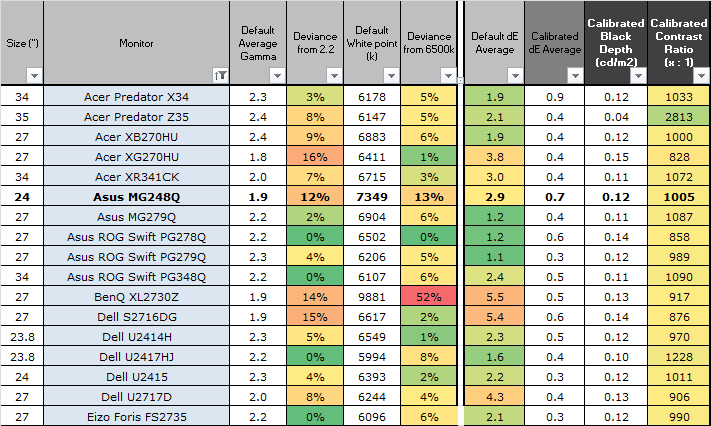
The comparisons made in this section try to give
you a better view of how each screen performs, particularly out of the box which
is what is going to matter to most consumers. When comparing the default factory
settings for each monitor it is important to take into account several
measurement areas - gamma, white point and colour accuracy. There's no point
having a low dE colour accuracy figure if the gamma curve is way off for
instance. A good factory calibration requires all 3 to be well set up. We have
deliberately not included luminance in this comparison since this is normally
far too high by default on every screen. However, that is very easily controlled
through the brightness setting (on most screens) and should not impact the other
areas being measured anyway. It is easy enough to obtain a suitable luminance
for your working conditions and individual preferences, but a reliable factory
setup in gamma, white point and colour accuracy is important and not as easy to
change accurately without a calibration tool.
From these comparisons we can also compare the
calibrated colour accuracy, black depth and contrast ratio. After a calibration
the gamma, white point and luminance should all be at their desired targets.
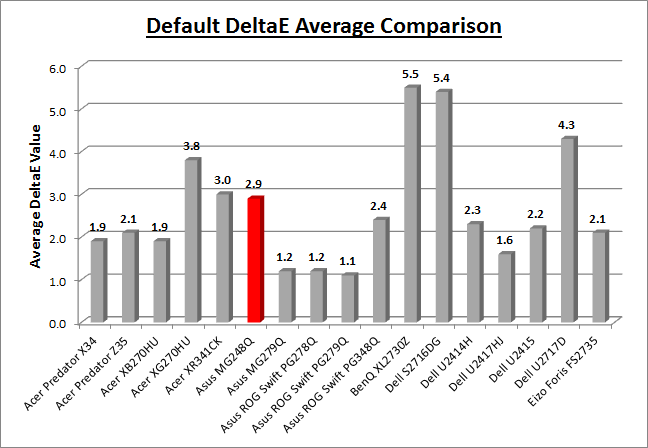
Default setup of the screen out of the box was not
that great for general day to day desktop use, since the screen was set up more
for gaming requirements. Many screens aimed at the gaming market are set up in
this way so we can't be too harsh on them as it's deliberate. However, users
should be aware that for non gaming / non multimedia use there are some
limitations and it's not always easy to correct some of the settings if you want
to. On the MG248Q the main issue is the gamma, which is 1.9 - 2.0 average and quite a
long way off the 2.2 target. With no gamma controls in the OSD menu, it's hard
to correct this without a calibration device (or maybe our calibrated ICC
profile in some cases). The other areas like the white
point (which was 13% out and too cool) can be corrected quite well by basic OSD
changes. The TN Film panel did at least offer a good calibrated contrast ratio
though. If you're after a more rounded screen for other uses besides gaming,
then other models can deliver better setup out of the box. The
Dell U2414H and
U2417HJ for instance are more rounded IPS-based panels in the 24" space and
have a better overall default setup. They won't match the raw gaming performance
of this screen though.
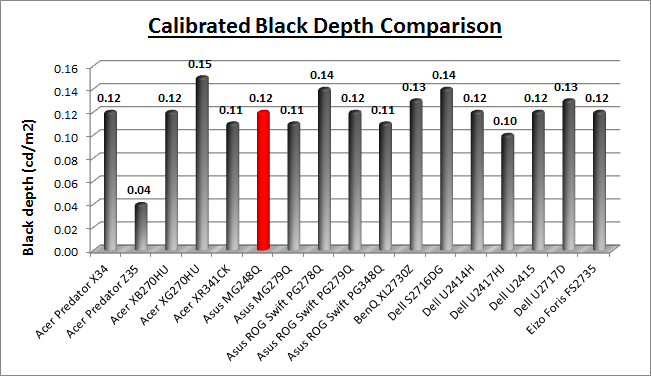
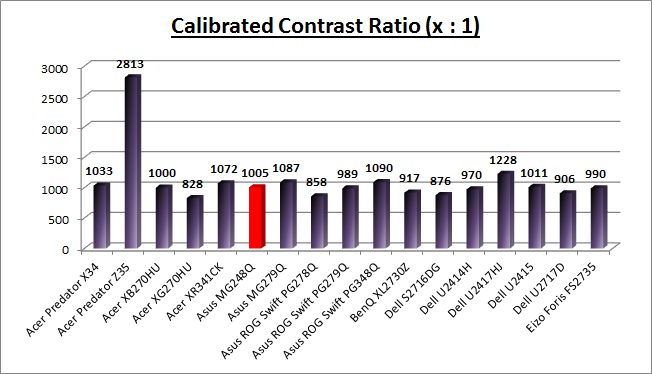
The display was decent when it came to contrast
ratio for a TN Film panel. It offered a 1005:1 calibrated contrast ratio,
putting it a bit ahead of other TN Film screens like the
Acer XG270HU (828:1),
Asus ROG Swift PG278Q (858:1),
BenQ XL2730Z (917:1) and
Dell S2716DG (876:1). Of course it can't compete with VA panel types which
can reach over 2000:1 easily, and commonly up to around 3000:1 like the
Acer Predator Z35 shown here for example.
|
Check Pricing and Buy - Direct Links
|
|
Amazon USA |
Amazon UK |
Overclockers UK |
Amazon GER |
Amazon CAN
|
|
TFTCentral is a participant
in the Amazon Services LLC Associates Programme, an affiliate
advertising programme designed to provide a means for sites to earn
advertising fees by advertising and linking to Amazon.com, Amazon.co.uk,
Amazon.de, Amazon.ca and other Amazon stores worldwide. We also
participate in a similar scheme for Overclockers.co.uk. |

Viewing Angles

Above: Viewing
angles shown from front and side, and from above and below. Click for
larger image
Viewing angles of the screen were as you might
expect from a TN Film panel. Unfortunately this panel technology is inherently
poor in this field, and so viewing angles are more restrictive than other
competing technologies like IPS and VA variants. Although the manufacturer will
quote a viewing angle of 170 / 160 (a classic indication that a TN Film panel is
being used by the way if in doubt), in practice there are some obvious contrast
and colour tone shifts horizontally, and especially vertically.
As you move your head from side to side in a
horizontal plane, there is a contrast shift and the image becomes more pale and
introduces a slight yellow hue. As you move to a wider angle the image can
become more washed out as well and a slight pink hue is introduced. Vertically
the fields of view are more restrictive still. From above the image becomes pale
and washed out, while from below there is a characteristic TN Film darkening of
the image. Unfortunately vertically the viewing angles will introduce noticeable
shifts in the contrast and colour tone of the image which mean that for any
colour critical work it is not really very well suited. TN Film panels have long
suffered from these restrictive viewing angles due to the nature of their pixel
structure. They are still fine for a single user for general use and certainly
the TN Film panels offer their advantages when it comes to
pixel
response times and refresh rate for gaming. If however, you were hoping to
do any colour critical or photography work you may find these shifts in the
appearance of the image difficult. An IPS-type panel would probably be a wiser
choice if you were looking for a screen with much wider viewing angles but
having said that you are probably mainly interested in gaming if you are
considering this screen. Remember, the MG248Q is specifically designed for
gaming, and so you will have to live with some of the sacrifices of TN Film to
get the kind of gaming performance and features offered here. There are some
high refresh rate gaming IPS panels available now in larger sizes as well which
can offer better viewing angles than TN Film models, although they are normally
priced higher and have some other characteristic differences, and so TN Film
models like this still have their place for many users.
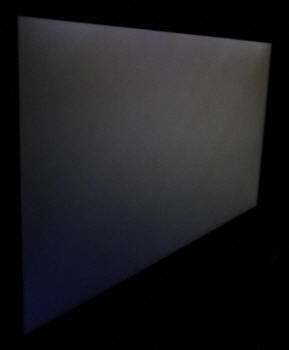
Above: View of an
all black screen from the side. Click for larger version
On a black image there is a moderate pale grey
tint introduced to the image when viewed from a wide angle. This isn't too
severe and shouldn't present any real problems in practice. Certainly not the
obvious white glow you get from most modern IPS-type panels in similar
situations and fairly standard for a TN Film panel. Very similar to what we have
seen from other recent gaming TN Film screens like the
Asus ROG Swift PG278Q and
BenQ XL2730Z. The glow you see from most modern IPS panels can put off some
users. So on the one hand, those IPS models have much better general viewing
angles than the TN Film models, but they do show more glow which some people
find an issue.

Panel Uniformity
We wanted to test
here how uniform the brightness was across the screen, as well as identify any
leakage from the backlight in dark lighting conditions. Measurements of the
luminance were taken at 35 points across the panel on a pure white background.
The measurements for luminance were taken using BasICColor's calibration
software package, combined with an X-rite i1 Display Pro colorimeter with a
central point on the screen calibrated to 120 cd/m2. The below
uniformity diagram shows the difference, as a percentage, between the
measurement recorded at each point on the screen, as compared with the central
reference point.
It is worth
noting that panel uniformity can vary from one screen to another, and can depend
on manufacturing lines, screen transport and other local factors. This is only a
guide of the uniformity of the sample screen we have for review.

Uniformity of Luminance

The luminance uniformity of the screen was
pretty good overall. The central regions
and lower half of the screen remained within a small 5 - 10% deviance from
the centrally calibrated point. The upper corners, especially the top left
region,
showed the most variation, where luminance dropped down to 93
cd/m2
in the most extreme example. Approximately two thirds of the screen was
within a 10% deviance threshold which was not bad.

Backlight Leakage
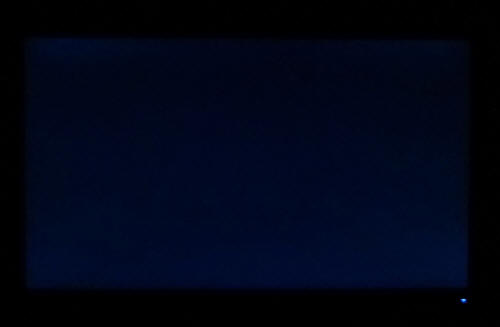
Above: All black screen in a darkened room. Click for larger version
We also tested the screen with an all black image
and in a darkened room. A camera was used to capture the result. The camera
showed there was some slight clouding detected in the top left corner and some
along the bottom edge and corners. This was not possible to see this during
normal every day uses though and was nothing severe.
Note: if you want to test your own screen for
backlight bleed and uniformity problems at any point you need to ensure you have
suitable testing conditions. Set the monitor to a sensible day to day brightness
level, preferably as close to 120
cd/m2 as you can get it (our tests are
once the screen is calibrated to this luminance). Don't just take a photo at the
default brightness which is almost always far too high and not a realistic usage
condition. You need to take the photo from about 1.5 - 2m back to avoid
capturing viewing angle characteristics, especially on IPS-type panels where
off-angle glow can come in to play easily. Photos should be taken in a darkened
room at a shutter speed which captures what you see reliably and doesn't
over-expose the image. A shutter speed of 1/8 second will probably be suitable
for this.

General and Office Applications
With a 1920 x 1080 resolution, the desktop real
estate of the MG248Q feels a step down compared with all the high
resolution panels we've tested, and the 27" 2560 x 1440 models we are used to
using day to day. You do lose a large amount of desktop space, and although side
by side split screen working is possible, it's not as easy due to the more
limited resolution and space. With a 0.2745mm pixel pitch, text is comfortable
and easy to read natively, providing a sharp and crisp image. It is not as sharp
as the 1440p panels we've become accustomed to, or of course any ultra HD/4K
resolutions where scaling is used, but it is perfectly adequate. For this size
screen, 1920 x 1080 is about your limit of sensible resolution without needing
to use operating system scaling options.
The moderate AG coating of the TN Film panel could
be considered a bit grainy, especially on white office backgrounds to a lot of
people. It's not as clear as modern IPS coatings or any semi-glossy solution.
Still, it's not as grainy as old IPS panels and is on par with other TN Film
matrices we've tested. Perhaps the main issue with this panel technology though
is the restrictive viewing angles, making contrast and colour tone shifts a bit
of a problem when it comes to colour critical work. They are the same here as
other TN Film panels, being restrictive especially vertically. The screen is
fine when viewed head on though really for office and text work, but for colour
critical work or photo editing etc you'd be better off with an IPS-type panel.
The default setup of the screen was a bit restrictive for normal uses, as the
gamma is set up more for gaming, and hard to adjust without a calibration tool
(or maybe our calibrated ICC profile). There are 5 blue light filter modes
offered here if you want to add further eye care protection and might be worth
experimenting with for prolonged office use.
The brightness
range of the screen was very good, with the ability to offer a luminance between
346 and 71 cd/m2. This should mean the screen is perfectly useable in
a wide variety of ambient light conditions, including darkened rooms. A setting
of ~17 in the OSD brightness control should return you a luminance
close to 120 cd/m2 out of the box if you stick to the default
preset mode. Otherwise you might want to try the settings from our
calibration
section. On another positive note, the brightness regulation is controlled
without the need for the use of the now infamous
Pulse-Width Modulation (PWM), and so those who suffer from eye fatigue or
headaches associated with flickering backlights need not worry. There was no audible noise or buzzing from the screen, even when specifically
looking for it using test images with a large amount of text at once. The screen
also remains cool even during prolonged use.
There aren't
really any extra features on this screen for office environments, since it's
primarily a gaming screen. There's not even any USB ports on this model which is
pretty rare now for any screen. No ambient light sensor, card reader, motion
sensors or anything either.
There was at least a good range of ergonomic adjustments available from the stand
allowing you to obtain a comfortable position for a wide variety of angles. The
VESA mounting support may also be useful to some people as well. 2x 2W stereo
speakers might be useful for the odd mp3 or Youtube video and a headphone out
port is also provided.

Above: photo of
text at 1920 x 1080 (top) and 1600 x 900 (bottom)
The screen is designed to run at its native
resolution of 1920 x 1080 and at a 60Hz recommended refresh rate. However,
if you want you are able to run the screen outside of this resolution. We tested
the screen at a lower 1600 x 900 resolution to see how the screen handles the
interpolation of the resolution, while maintaining the same aspect ratio of
16:9. At native resolution the text was sharp and clear. When running at a the
lower resolution the text shows quite high
levels of blurring. You also lose a lot of screen real-estate as well of course
so where possible it is best to run at 1920 x 1080.

Responsiveness and Gaming
|
Quoted G2G Response Time |
1ms G2G |
|
Quoted ISO Response Time |
n/a |
|
Panel Manufacturer and
Technology |
AU Optronics TN Film |
|
Panel Part |
M240Q007 V0 |
|
Overdrive Used |
Yes |
|
Overdrive Control Available to
User |
Trace Free setting |
|
Overdrive Settings |
0, 20, 40, 60, 80, 100 |
The MG248Q is rated by Asus as having a 1ms G2G response time, which indicates the panel uses
overdrive /
response time compensation (RTC) technology to boost pixel transitions
across grey to grey changes. There is a user control for the overdrive impulse
via the OSD menu, using the 'Trace Free' setting. The
part
being used is the
AU Optronics M240Q007 V0 TN Film technology panel. Have a read about response time in
our
specs section if you need additional information about this measurement.
We will first test the screen using our thorough
response time testing method. This uses an oscilloscope and photosensor to
measure the pixel response times across a series of different transitions, in
the full range from 0 (black) to 255 (white). This will give us a realistic view
of how the monitor performs in real life, as opposed to being reliant only on a
manufacturers spec. We can work out the response times for changing between many
different shades, calculate the maximum, minimum and average grey
to grey (G2G) response times, and provide an evaluation of any overshoot present
on the monitor.
It is worth noting that with a 1920 x 1080
resolution, this screen should be easier to power for most systems than the wide
range of 2560 x 1440 screens (and above) which are now popular. If you have a
lower end system or graphics card then you will find this resolution less of a
demand certainly.
We use an
ETC M526
oscilloscope for these measurements along with a custom photosensor device.
Have a read of
our response time measurement article for a full explanation of the testing methodology and reported
data.

Trace Free Setting

The MG248Q has 5 settings for the overdrive
control available in the OSD menu, under the Trace Free option. We carried out
various motion tests to establish the optimum setting here. To the naked eye it
was easy to see the difference between each settings. These results were the
same from both an NVIDIA and an AMD test system which was good news. We have
seen some FreeSync screens behave poorly when connected to a FreeSync system,
where the overdrive control is often disabled or operates very differently.
Thankfully the overdrive control (via the Trace Free setting) behaved fine on
both systems.
It should be noted however that the response times
behave a little differently depending on the refresh rate. We tested the
response times at 60Hz and 144Hz at various Trace Free settings to try and
establish which the optimal setting was. Keep in mind what refresh rate you are
going to use on the screen, depending on requirements. Also if you use FreeSync
the refresh rate will dynamically change within the 40 - 144Hz range also
depending on your system and frame rate output.
60Hz Refresh Rate



At TF 0 there was a pretty
large amount of motion blur to a moving image, where the overdrive impulse had
been turned off. As you switch up to 20, the blurring is reduced a bit but it's
still at pretty high levels in some cases. The average G2G response time
measured here was 7.2ms, but some transitions were much slower where the
overdrive impulse was perhaps not aggressive enough. At TF 40 the blurring was reduced quite significantly
and the moving image looked sharper and clearer. You can see from our response
time measurements at this setting above that we recorded a 3.4ms G2G average
response time which was very good. Some transitions started to show some
moderate to high levels of overshoot but this was hard to see in practice and
didn't seem to affect the screen too much. It should be noted that at TF 0 and
20 there was no overshoot at all, as the overdrive impulse was very modest.
Once you pushed TR up to 60 there was very little
change to the actual response times, but a dark overshoot trail started to
become very noticeable. Our measurements above show that the overshoot was
severe at this TR 60 setting. At 80 and 100 it was even more pronounced in
practice, where the overdrive impulse was just too aggressive. So at 60Hz, TR 40
seemed to be optimal.
144Hz Refresh Rate


With a higher refresh rate of 144Hz active, the
response time behaviour was a little different. At TF 20 the response times were
a bit faster now than they had been at lower refresh rates, with a 4.4ms G2G
response time measured. Some overshoot started to creep in though but nothing
too obvious. At TF 40, the response times had been pushed a little faster than
at 60Hz, but the overshoot was starting to become more noticeable.
We still felt that in actual use and fast moving
content the TF 40 setting gave the optimal response time behaviour overall,
especially at the lower end of the refresh rate range. If you are pushing higher
frame rates towards the top end of the refresh rate range consistently, and
start to find that the overshoot becomes too apparent, dropping down to TF 20
might be worth a try. If you're more at the lower end of the refresh rate range,
or using the screen for external 60Hz consoles etc, TF 40 is certainly optimal.

Detailed Response Time Measurements
We took the following measurements at the maximum
144Hz refresh rate and with the Trace Free setting at 40.
 
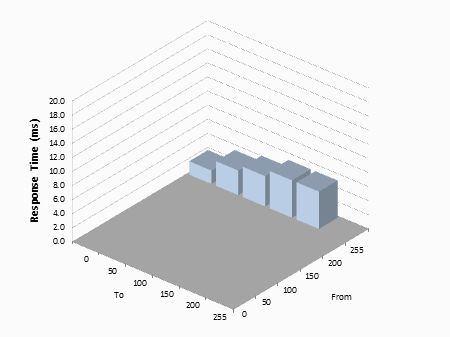
The average G2G response time was measured at 3.2ms which was
very good and on par with the other recent TN Film gaming panels we've tested.
Rise times (changes from dark to light shades) were slightly slower than fall
times (changes from light to dark shades) but not by anything significant. Some
measurements reached just about to the 1ms G2G specification as well (1.1ms was
the lowest measured).
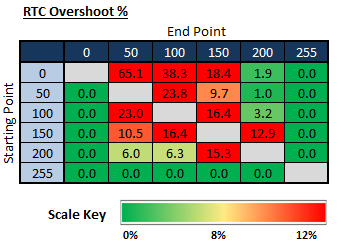
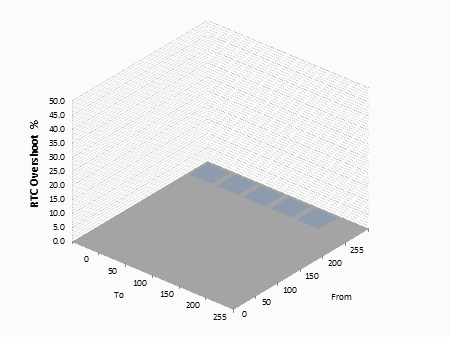
If we evaluate the Response Time Compensation
(RTC) overshoot then the results are a bit disappointing at this maximum refresh
rate of 144Hz. There are quite high levels of overshoot across quite a lot of
the transitions, some of them reaching up to very high levels (e.g. 0 > 50 = 65.1%
overshoot). Remember, this overshoot was higher when running at 144Hz, and
reduced down to more moderate levels as the refresh rate lowered. So you won't
see this overshoot in practice unless you're running consistently at the top end
of the refresh rate range. We felt TF 40 delivered the best response time
performance across the refresh rate range overall, but the overshoot was a
little too high when it reached the top end, without really much reduction in
the pixel response times. We would have preferred a slightly less aggressive
overdrive impulse we think for higher refresh rates. TF of 30 might have been ideal if it was available!

Display Comparisons
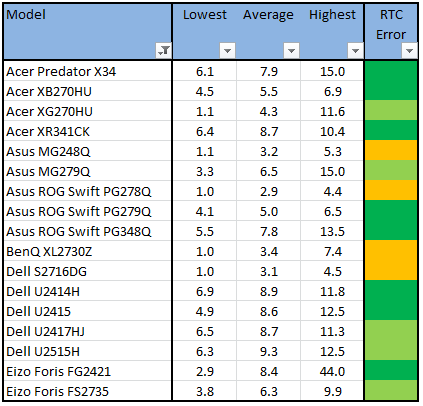
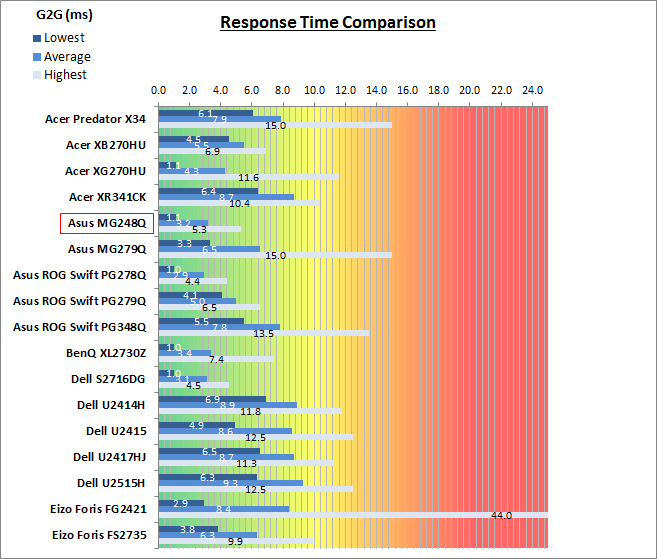
The above comparison table and graph shows you the
lowest, average and highest G2G response time measurement for each screen we
have tested with our oscilloscope system. There is also a colour coded mark next
to each screen in the table to indicate the RTC overshoot error, as the response
time figure alone doesn't tell the whole story.
The response time performance of the MG248Q is on
par with the other modern TN Film gaming screens we've tested. With an average G2G
response time of 3.2ms it offers decent pixel transition times like popular
models like the
Asus ROG Swift PG278Q (2.9ms),
BenQ XL2730Z (3.4ms) and
Dell
S2716DG (3.1ms) for instance. Each of these models shows moderate to high levels
of overshoot which is quite common for the fastest TN Film panels, as
manufacturers push response times as low as they can and try to meet the
desirable 1ms G2G spec. At the full 144Hz refresh rate, the overshoot was higher
on the MG248Q than those other mentioned models by a bit, but as we've explained
in the previous section, as the refresh rate lowers the overshoot is reduced so
we feel that overall (and considering dynamic refresh rate ranges offered here
by G-sync/FreeSync) it's pretty much on par with those other gaming screens.
These TN Film gaming screens remain a bit faster
than the IPS-type models available (e.g.
Acer Predator XB270HU,
Asus ROG Swift
PG279Q), including those that now support high refresh rates of 120Hz and above.
They 'feel' a bit snappier and sharper than IPS panels, although you do need to
live with some moderate to high levels of overshoot in practice on the TN Film
models, whereas a lot of the high refresh rate IPS panels are overshoot free.
It's a bit of a balancing act, depending on your needs. To be honest, many users
wouldn't notice much practical difference between those two types of screen so
it's nothing much to worry about.
The screen was also tested using the chase test in
PixPerAn for the following display comparisons. As a reminder, a series of
pictures are taken on the highest shutter speed and compared, with the best case
example shown on the left, and worst case example on the right. This should only
be used as a rough guide to comparative responsiveness but is handy for a
comparison between different screens and technologies as well as a means to
compare those screens we tested before the introduction of our oscilloscope
method.

24"
1ms
G2G AU Optronics TN Film @ 144Hz (Trace Free = 40)
In practice the MG248Q showed low levels of
blurring and a sharp and clear moving image. With high refresh rate support up
to 144Hz you also get additional benefits in perceived motion blur and the
screen is a step above any 60Hz refresh rate panels on the market. At the high
end of the 144Hz refresh rate range, and with Trace Free at 40, some dark
overshoot starts to creep in as you can see above. This reduces as the refresh
rate lowers which we talked about earlier.

24"
1ms
G2G AU Optronics TN Film @ 144Hz (Trace Free = 40)

27"
1ms
G2G AU Optronics TN Film @ 144Hz (Response Time = Normal)

27"
1ms
G2G AU Optronics TN Film @ 144Hz (OD = Normal)

27"
1ms
G2G AU Optronics TN Film @ 144Hz (AMA = High)
If we compare the MG248Q to some other recent
gaming screens we've tested with TN Film panels the performance is very
comparable. Response times are at a similar level and in practice the levels of
blurring and overshoot are on par with one another.

24"
1ms
G2G AU Optronics TN Film @ 144Hz (Trace Free = 40)

27"
4ms
G2G AU Optronics AHVA (IPS-type) @ 144Hz (OD = Normal)

27"
4ms G2G AU Optronics AHVA (IPS-type)
@ 144Hz (OD = Normal)

27"
4ms
G2G AU Optronics AHVA (IPS-type) @ 144Hz (Trace Free = 80)
The above images compare the MG248Q then with the
three high refresh rate IPS-type panels we've tested. In practice the IPS models
show smooth and fluid movement and are also free of any noticeable overshoot as
well which is pleasing. The TN Film models like the Asus MG248Q are slightly
faster, and have a slightly different "feel" than the IPS models, but most users
would be perfectly happy with any of the options here for gaming.

Additional Gaming Features
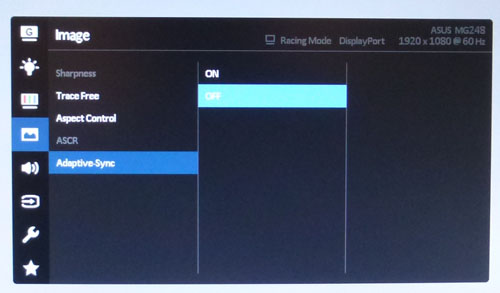
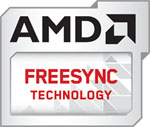
FreeSync Support -
For those with a suitable graphics card, the MG248Q supports Adaptive Sync,
offering a dynamic refresh rate range between 40 and 144Hz. This provides a
decent lower end of the range, as well as supporting up to the maximum refresh
rate of the monitor which is good news. Have a read of our
Variable Refresh Rates article for more information on the benefits of
Adaptive Sync / FreeSync. Since the screen is using FreeSync and not NVIDIA
G-sync Asus have not had to sacrifice anything in the way of video inputs or
scalers etc. Thankfully they've also managed to keep the
input lag low.
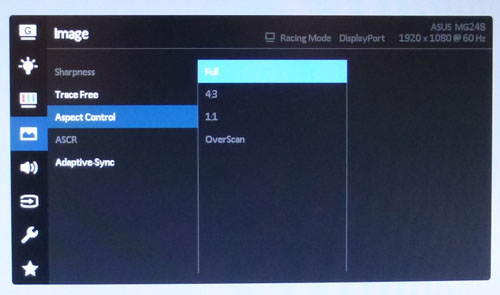
Aspect Ratio Control -
the screen has 4 options for
aspect ratio control through the OSD 'image' menu as shown above. There
are options for full, 4:3, 1:1 pixel mapping and overscan. There is oddly no
"aspect ratio" option for maintaining the source aspect at whatever it is, but
filling as much as the screen as possible. It's probably not a major issue as
1:1 pixel mapping is offered and the resolution of this panel is low anyway. External devices
are generally 16:9 aspect
ratio by default at 1080p now, so the native resolution/aspect ratio of the screen can
accommodate that nicely.
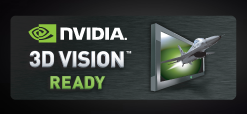
NVIDIA 3D Vision 2 -
We felt like this was a bit of an odd addition really. Some users will maybe
want to use NVIDIA 3D Vision for their gaming, but with the screen being more
aimed at an AMD graphics card market (with the FreeSync support), it felt like a
bit of a mis-match. If you have an AMD card you can use FreeSync, but won't be
able to use NVIDIA 3D Vision. If you have a compatible NVIDIA card you can use
3D Vision but not FreeSync. Still, it's there if you need it.


LightBoost (Blur Reduction Hack) - with
NVIDIA 3D Vision 2 being supported, you can also make use of the LightBoost
system if you want for some blur reduction benefits. It would have been nice to
see a native blur reduction mode included on the screen, but NVIDIA users can at
least use the hack method if they want. Have a read of our
Motion Blur Reduction Backlights article for more information.

GamePlus features - available via the OSD
menu is a series of game enhancements as shown above. Might be useful to some
serious gamers.

Preset Modes -
There are various preset modes available as shown
above, and most can be altered quite well to your personal taste. These might be
useful to quickly switch between different uses, certainly if you want a
different setup for gaming than for general desktop use which is quite common.

Lag
We have written an in depth article about
input lag and the various measurement techniques which are used to evaluate
this aspect of a display. It's important to first of all understand the
different methods available and also what this lag means to you as an end-user.
Input Lag vs. Display Lag vs. Signal
Processing
To avoid confusion with different terminology we
will refer to this section of our reviews as just "lag" from now on, as there
are a few different aspects to consider, and different interpretations of the
term "input lag". We will consider the following points here as much as
possible. The overall "display lag" is the first, that being the delay between
the image being shown on the TFT display and that being shown on a CRT. This is
what many people will know as input lag and originally was the measure made to
explain why the image is a little behind when using a CRT. The older stopwatch
based methods were the common way to measure this in the past, but through
advanced studies have been shown to be quite inaccurate. As a result, more
advanced tools like SMTT provide a method to measure that delay between a TFT
and CRT while removing the inaccuracies of older stopwatch methods.
In reality that lag / delay is caused by a
combination of two things - the signal processing delay caused by the TFT
electronics / scaler, and the response time of the pixels themselves. Most
"input lag" measurements over the years have always been based on the overall
display lag (signal processing + response time) and indeed the SMTT tool is
based on this visual difference between a CRT and TFT and so measures the
overall display lag. In practice the signal processing is the element which
gives the feel of lag to the user, and the response time of course can
impact blurring, and overall image quality in moving scenes. As people become
more aware of lag as a possible issue, we are of course keen to try and
understand the split between the two as much as possible to give a complete
picture.
The signal processing element within that is quite
hard to identify without extremely high end equipment and very complicated
methods. In fact the studies by Thomas Thiemann which really kicked this whole
thing off were based on equipment worth >100,1000 Euro, requiring extremely high
bandwidths and very complicated methods to trigger the correct behaviour and
accurately measure the signal processing on its own. Other techniques which are
being used since are not conducted by Thomas (he is a freelance writer) or based
on this equipment or technique, and may also be subject to other errors or
inaccuracies based on our conversations with him since. It's very hard as a
result to produce a technique which will measure just the signal processing on
its own unfortunately. Many measurement techniques are also not explained and so
it is important to try and get a picture from various sources if possible to
make an informed judgement about a display overall.
For our tests we will continue to use the SMTT
tool to measure the overall "display lag". From there we can use our
oscilloscope system to measure the response time across a wide range of grey to
grey (G2G) transitions as recorded in our
response time
tests. Since SMTT will not include the full response time within its
measurements, after speaking with Thomas further about the situation we will
subtract half of the average G2G response time from the total display lag. This should allow us to give a good estimation of
how much of the overall lag is attributable to the signal processing element on
its own.
Lag Classification
To help in this section we will also introduce a broader classification system
for these results to help categorise each screen as one of the following levels:
-
Class 1)
Less than 16ms / 1 frame lag - should be fine for gamers, even at high levels
-
Class
2)
A lag of 16 -
32ms / One to two frames - moderate lag but should be fine for many gamers.
Caution advised for serious gaming and FPS
-
Class
3)
A lag of more
than 32ms / more than 2 frames - Some noticeable lag in daily usage, not
suitable for high end gaming
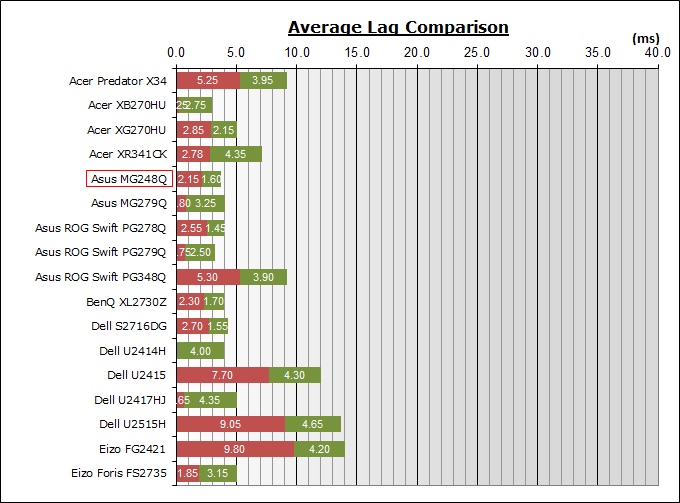
For the full reviews of the models compared here and the dates they were written
(and when screens were approximately released to the market), please see our
full
reviews index.
|
(Measurements in ms) |
|
|
Total Display Lag (SMTT
2) |
3.75 |
|
Pixel Response Time
Element |
1.60 |
|
Estimated Signal
Processing Lag |
2.15 |
|
Lag Classification |
1 |
|

Class
1 |
We have provided a comparison above against other
models we have tested to give an indication between screens. The screens
tested are split into two measurements which are
based on our overall display lag tests (using SMTT) and half the average G2G
response time, as measured by the oscilloscope. The response time is split from
the overall display lag and shown on the graph as the green bar. From there, the
signal processing (red bar) can be provided as a good estimation.
The screen showed a total average display lag of
only 3.75 ms as measured with SMTT 2. Taking into account half the average G2G
response time at 1.60ms, we can estimate that there is ~2.15 ms of signal processing lag on this screen. Basically nothing at
all. This is a very good result and puts it on par with other high end gaming
displays shown here.

Movies and Video

The following summarises the screens performance
in video applications:
-
24"
screen size makes it a reasonable option for an all-in-one multimedia screen,
but being quite a lot smaller than most modern LCD TV's of course.
-
16:9
aspect ratio is more well suited to videos than a 16:10 format screen, leaving
smaller borders on DVD's and wide screen content at the top and bottom.
-
1920 x
1080 resolution can support full 1080 HD resolution content
-
Digital interfaces support HDCP for any encrypted and protected content
-
Good range of connectivity options provided
with DisplayPort, HDMI and Dual-link DVI offered.
-
Cables provided in the box
for DisplayPort and
DL-DVI, but not HDMI.
-
Moderate AG coating provides reasonably clear images with no major graininess,
and without the unwanted reflections of a glossy solution. Some graininess
apparent as with other TN Film panels, but shouldn't present a problem in
movies.
-
Wide
brightness range adjustment possible from the display, including a maximum
luminance of ~346
cd/m2 and a decent minimum luminance
of 71 cd/m2. This should afford you good control for different
lighting conditions. Contrast ratio remains stable across that adjustment
range as well and is strong for a TN Film panel. Brightness regulation is
controlled without the need for PWM and so is flicker free for all brightness
settings.
-
Black
depth and contrast ratio are strong for a TN Film panel at 1005:1 after
calibration. Detail in darker scenes should not be lost as a result.
-
There
is a specific 'movie' preset mode available for movies or video if you want
but it is much cooler than our calibrated custom mode. May be useful to some though.
-
Very
good pixel responsiveness which should still be able to handle fast moving
scenes in movies without issue. Some overshoot issues start to creep in at
high refresh rates, but for movies and external devices they should run at
60Hz anyway. Try TF 40, but if you find there is any distracting overshoot, TF
20 should be more than sufficient for movies as well.
-
Viewing angles are limited due to the use of TN Film panel technology. May
cause issues with gamma and contrast shift if you change your line of sight or
have several people trying to see the screen at once. Not really an ideal
technology for movies as a result of this viewing angle limitation.
-
Very good and mostly easy to use range of
ergonomic adjustments available from the stand, so should be easy to obtain a
comfortable position if you want to sit further away
from the screen for movie viewing.
-
No
particularly noticeable backlight leakage, and none from the edges which is
good. This type of leakage may prove an issue when watching movies where black
borders are present but it is not a problem here.
-
2x 2W
integrated stereo speakers on this model for the occasional movie clip and
Youtube video, but probably not suitable for movie viewing. There is also an
audio input and headphone output connection if needed.
-
Good
range of
hardware aspect ratio options with full, 4:3, 1:1 and overscan modes available which
should be fine for most uses.
-
Picture in picture (PiP) and Picture By Picture (PbP) are not available.
-
NVIDIA
3D Vision 2 supported for 3D movies if you have a compatible graphics card and
content.

Conclusion
The Asus MG248Q was a very solid gaming screen in
the 24" space. The key areas of interest for this screen are where it did
particularly well. It offered fast response times which were on par with other
top-end TN Film gaming screens we've tested in recent months. There was high
refresh rate support up to 144Hz, with a good FreeSync range also of 40 - 144Hz
available. The low lag which was excellent news as well. Somewhat disconnected
is the support for NVIDIA 3D Vision and LightBoost blur reduction hacks if you
have an NVIDIA system, so although this is primarily aimed at AMD users (because
of the FreeSync support) it's still an interesting choice for NVIDIA users.
The default setup of the screen is more aimed at
gamers as well, with a low gamma and slightly cool colour temperature.
Unfortunately that did mean it was a little bit restrictive for more general
desktop uses, as the gamma is a bit hard to correct unless you have a
calibration device. We would have welcomed more control over the gamma from the
screen to overcome this. On the plus side, the contrast ratio was strong for a
TN Film panel and you had a decent backlight adjustment range as well. You also
need to be aware of the limitations of TN Film technology of course,
particularly when it comes to the viewing angles which impact image quality and
limit any colour critical work. It's firmly a gaming technology really and at
least delivers well in that area.
We liked the functionality and ease of use of the
stand, and it was nice to see a decent range of connections and OSD options
provided. The flicker free backlight was welcome as ever. Although not
officially a ROG branded screen, the design was very nice and it looked very
much like the ROG Swift PG278Q and PG279Q models at the end of the day. If
you're after a solid gaming screen in the 24" space, this is a great option.
If you appreciate the review and enjoy reading and like our work, we would welcome a
donation
to the site to help us continue to make quality and detailed reviews for you.
|
Pros |
Cons |
|
Excellent gaming performance
with fast response times, high refresh rate, low lag and FreeSync support |
Default setup aimed at gaming
and not as good for general uses |
|
Nice premium design, quite
similar to the ROG Swift range |
Limitations of TN Film
technology when it comes to viewing angles particularly |
|
Nice range of gaming extras
and features |
Some overshoot starts to
become high at top end of refresh rate range (TF 40) |
|
Check Pricing and Buy - Direct Links
|
|
Amazon USA |
Amazon UK |
Overclockers UK |
Amazon GER |
Amazon CAN
|
|
TFTCentral is a participant
in the Amazon Services LLC Associates Programme, an affiliate
advertising programme designed to provide a means for sites to earn
advertising fees by advertising and linking to Amazon.com, Amazon.co.uk,
Amazon.de, Amazon.ca and other Amazon stores worldwide. We also
participate in a similar scheme for Overclockers.co.uk. |
|
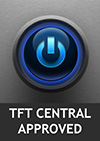
|
TFT Central Awards Explained
We have two award
classifications as part of our reviews. There's the top 'Recommended'
award, where a monitor is excellent and highly recommended by us. There is
also an 'Approved' award for a very good screen which may not be perfect,
but is still a very good display. These awards won't be given out every
time, but look out for the logo at the bottom of the conclusion. A list of
monitors which have won our awards is available
here. |
|